Introduction
It's another precious week of learning at the academy and I'm glad to be in attendance of the new lectures presented by the professors. For this week, I have attended a lecture by professor
@pelon53 where the professor lectured on the topic
Hashgraph Technology, it's a great lecture, no doubt, and I will be solving the task given by the professor with this article.
Introduction to Hashgraph Technology
Hashgraph technology is considered as an advanced distributed ledger technology that has come into the crypto ecosystem to bring about innovation that performs better than the early distributed ledger system (blockchain) employed by most cryptocurrencies.
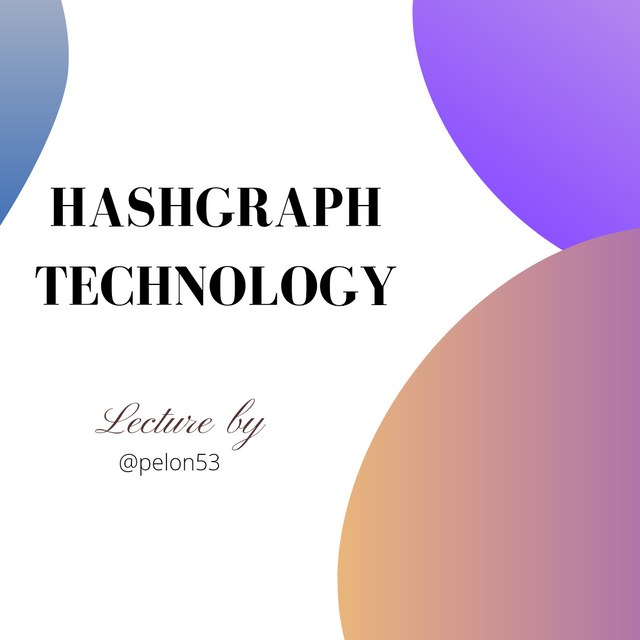
Hashgraph Technology is aimed at improving the efficiency of transactions on the network with characteristics of high scalability; processing large transactions per second and securely done. Crypto networks employ different consensus algorithms like Proof of Work (PoW), Proof of Stake (PoS)... and in the case of Hashgraph technology, Gossip Protocol is employed. I will talk more about Gossip technology as I progress in this article.
1. Explain in detail the Gossip protocol, used in Hashgraph.
Gossip protocol employed in Hashgraph technology is a protocol which distributes data throughout an entire system in a quest to reach a consensus about a transaction in the network. Gossip protocol works in the manner of Gossip about Gossip whereby a node in a system is capable of sending data to other nodes at random with the purpose to reach a consensus, all known data about a transaction by a node is sent to other nodes through Gossip packet in the quest of verifying a transaction and reaching a conclusion.
In addition, the Gossip protocol employed in Hashgraph technology doesn't only send data from one node to another but sends data in detail, highlighting all nodes that are already involved in the data; what the nodes have been doing before the data arrived, the time at which the data arrived other nodes, the interaction of the nodes with the data and many more. With this, there is continuous gossiping about gossip amongst nodes in the quest to reach a consensus that is faster than blockchain technology. For example, if node 1 sends data to node 2 in a distributed network, node 1 would specify other nodes that have interacted with the data, the time it happened, and many more which exposes all gossips about a data to the receiving node which in return sends it back to node 1. What an interesting technology!
Unlike Proof of Work (PoW) or Proof of Stake (PoS) consensus algorithm, Gossip protocol used as the Hashgraph consensus technology has its nodes sends all they know about a transaction thereby reducing the workload on a network and leads to faster, safer and secured transactions. Talking about the virtual voting in this protocol, it is easy to validate transactions as all system parts know other nodes involved in the transaction thereby enhances faster validation by reaching consensus.
Highlights of Gossip Protocol used in Hashgraph
All the data about a transaction is sent through a Gossip packet from one node to another including the details of nodes that are involved earlier with the time of interaction.
Transactions on the Hashgraph network that utilizes Gossip protocol are faster, safer, and secured, as it can process up to 10,000 transactions per second with almost instantaneous effect.
Validation is fair as all nodes can get involved in the process unlike the Proof of Work (PoW) where the next block is rewarded to the miner that was able to provide a solution to a computational equation.

2. Explain Tolerance to Byzantine Faults in Hashgraph
Firstly, let's talk about Byzantine Faults, it is simply an occurrence where a node in a distributed network tends to fail without other nodes in the network having the information about the failure.
Hashgraph is Asynchronous Byzantine Faults Tolerant which simply means transactions are only validated when nodes in a distributed network reach consensus and as such can be mathematically proven that the transaction validation would occur. A few things to note in Asynchronous Byzantine Faults Tolerant are listed below;
A consensus would be reached.
The information about the reached consensus would be made known in the network.
The consensus is proven mathematically that every nodes of the network are going to reach the same consensus.
Validation of transaction takes place after consensus is reached.
Hashgraph been Asynchronous Byzantine Tolerant implies that if 2/3 nodes of the network is valid then the nodes will reach consensus on a transaction. In other words, if less than 1/3 nodes of the network are malicious or invalid then the system will reach a consensus.

3. Make a comparison between Hashgraph Vs Blockchain, for a voting process in your country. Which technology would you choose? Why?
In this section of the task, I will like to make a comparison between Hashgraph and Blockchain under the characteristics; Scalability, Speed, Safety, Overall Efficiency. Then I would move on to virtual voting as a determinant to adopting Hashgraph technology for my country's (Nigeria) voting.
Comparison between Hashgraph and Blockchain
Scalability: Scalability been the ability of a network to handle many computing inputs at a time to give the desired results, Hashgraph is more scalable as transactions on the network are not delayed, transactions on the blockchain is often dependent on the work of the miners which can cause a delay in a transaction.
Speed: Hashgraph is proven to process transactions on a network up to 10,000 per second without any delay but the validation speed of transactions on the blockchain depends on the consensus algorithm employed by a particular network which could be Proof of Work (PoW) as seen in Bitcoin or Proof of Stake (PoS) as seen in Tron blockchain where speed of transaction is determined by the work of miners and the speed of transaction on the blockchain is way lesser as compared to Hashgraph's.
Safety: Safety in Hashgraph using the Gossip protocol is better as compared to blockchain's as transactions data are sent in whole to all nodes in the network thereby preventing malicious ones that tend to alter a transaction thereby reaching a consensus to validate a transaction.
Overall Efficiency: From the earliest points, we can deduce the fact that Hashgraph is highly efficient than Blockchain, and all the above-mentioned points are proven mathematically which authenticate that Hashgraph is efficient than Blockchain. Going further, mathematically proven theories can be subjected to further inquiries which in real life, Hashgraph might not be efficient as proven but Blockchain as employed by different cryptocurrency network has most of the properties proven even in real practical.
Hashgraph technology adoption for Voting in my Country and Why
For the voting process in my country, I will like to adopt Hashgraph technology and the reason for my choice is the Virtual voting component of the Hashgraph technology. Virtual Voting in Hashgraph technology is done in a manner that the nodes of the network know the node that has voted and the details of the vote in the quest to reach a consensus in a transaction. Now, adopting the Hashgraph Virtual Voting to be the voting algorithm in my country, makes the process of voting fair as all can participate in the exercise having all the nodes of the system sending all the data of a vote to another in the process of validating the process.
The adoption would complete the exercise by taking the data from nodes of the network to reach a consensus as such, we don't have to wait for compilation of votes after the voting exercise as the nodes would reach a consensus to produce a valid result for the process as obtained from the witness of each of the nodes. For example, if 2/3 of the nodes are valid then a consensus would be reached and this confirms the winner in a fair manner.

4. Explore Hedera Hashgraph. Show screenshots.
Hedera Hashgraph is at the moment of writing this article is the only authorized Hashgraph technology and knowing that Hashgraph technology is Asynchronous Byzantine Faults Tolerant, which is used to reach consensus provided that less
1/3 nodes of a network is invalid, the nodes would reach a consensus to validate a transaction. I will be exploring
hedera.com/. Hedera has its native cryptocurrency to be HBAR which has its value to be 0.224 USD and on the 53th position in ranking by market capitalization, as at the time of writing this article.
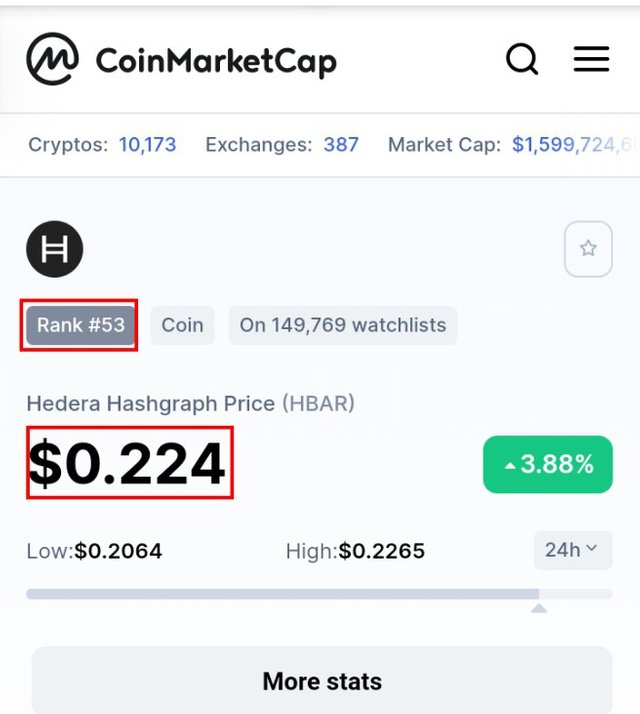
HBAR on coinmarketcap.com
- The exploration journey begins from visiting hedera.com/ from my mobile browser.
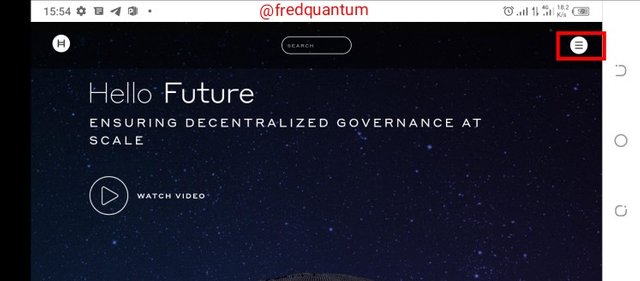
Hedera homepage
- Selecting the menu button by the top-right of the page shows the options available (Network, Dev, Use Cases, HBAR, Governance and About). See the screenshot below.
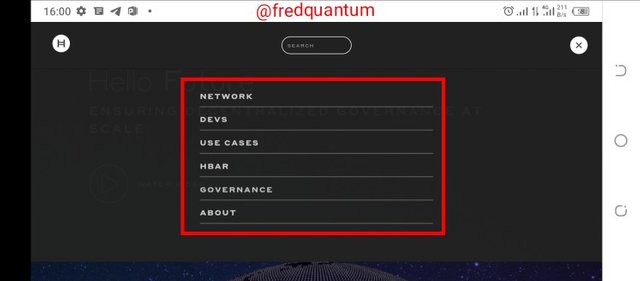
NETWORK: The network has the options Token Service that allows users to create own fungible and non-fungible tokens in the native Hedera network without deploying smart contract. Consensus Service for developers that offers Hedera Consensus Service API for verifiable timestamping and ordering of any event for application of choice or any permissioned blockchain. And other services available on the Network.
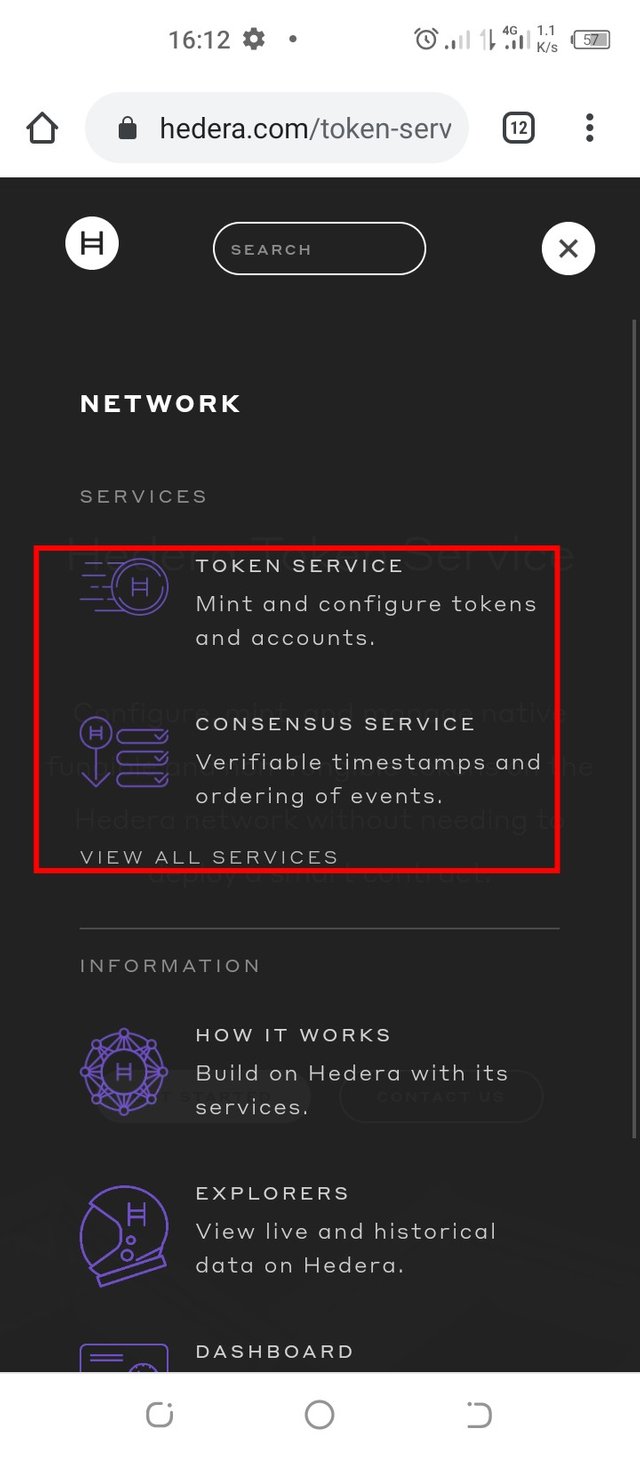
Hedera network
DEVS
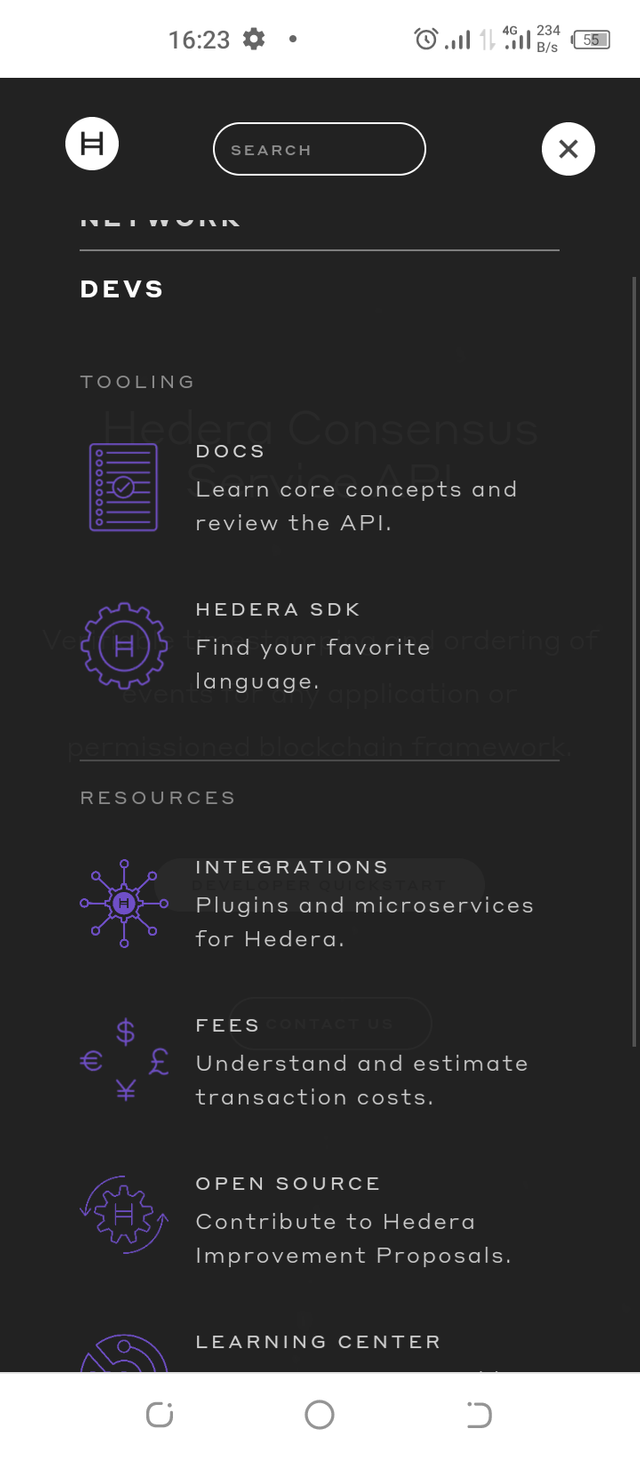
Devs
Under the DEVS, we have several options under it like; Tooling which has DOC- This contains all you need to know about Hedera Hashgraph, HEDERA SDK- which offers the Hedera API in different languages. Resources which has INTEGRATION- This allows users to integrate their existing application or permissioned blockchain framework into the Hedera network, FEES- that shows the fee schedules as decided the governing council, this could be useful for developers that wants to know the cost of integration in the Hedera network. Also under resources, we have the OPEN SOURCE option which tells a few things about Hedera Hashgraph on github and LEARNING CENTER- that take users on a ride about Hedera Hashgraph.
USE CASES
This section has some options which a few of them are; Payment, Tokenized assets, Fraud mitigation, Identity, Data Compliance, Permissioned blockchain- which allows users to create private ledger with public trust. And more options.
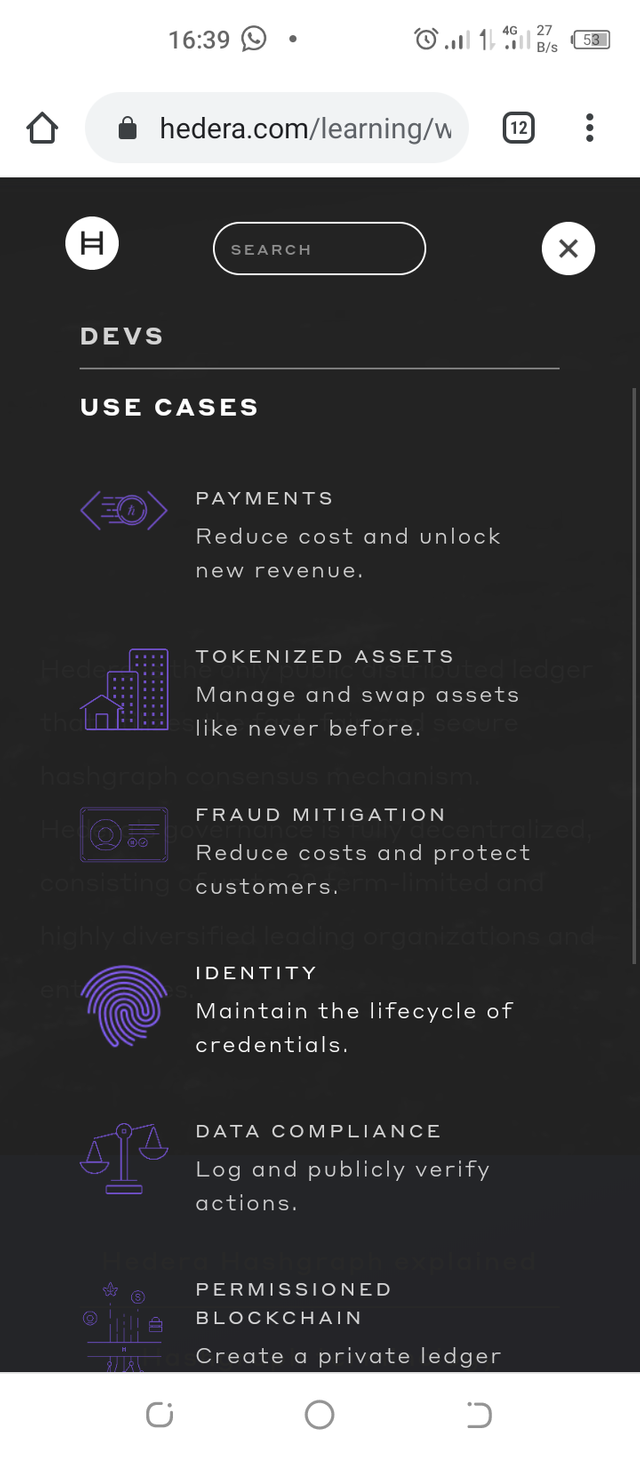
Use Cases
HBAR
This is the Hedera Hashgraph native token (HBAR) section which has the options; OVERVIEW- that give users details about the cryptocurrency, ACCOUNT CREATION- and this section allow users to create new Hedera mainnet account, WALLETS & EXCHANGES- this section tells users the available wallets and exchanges that supports the HBAR cryptocurrency.
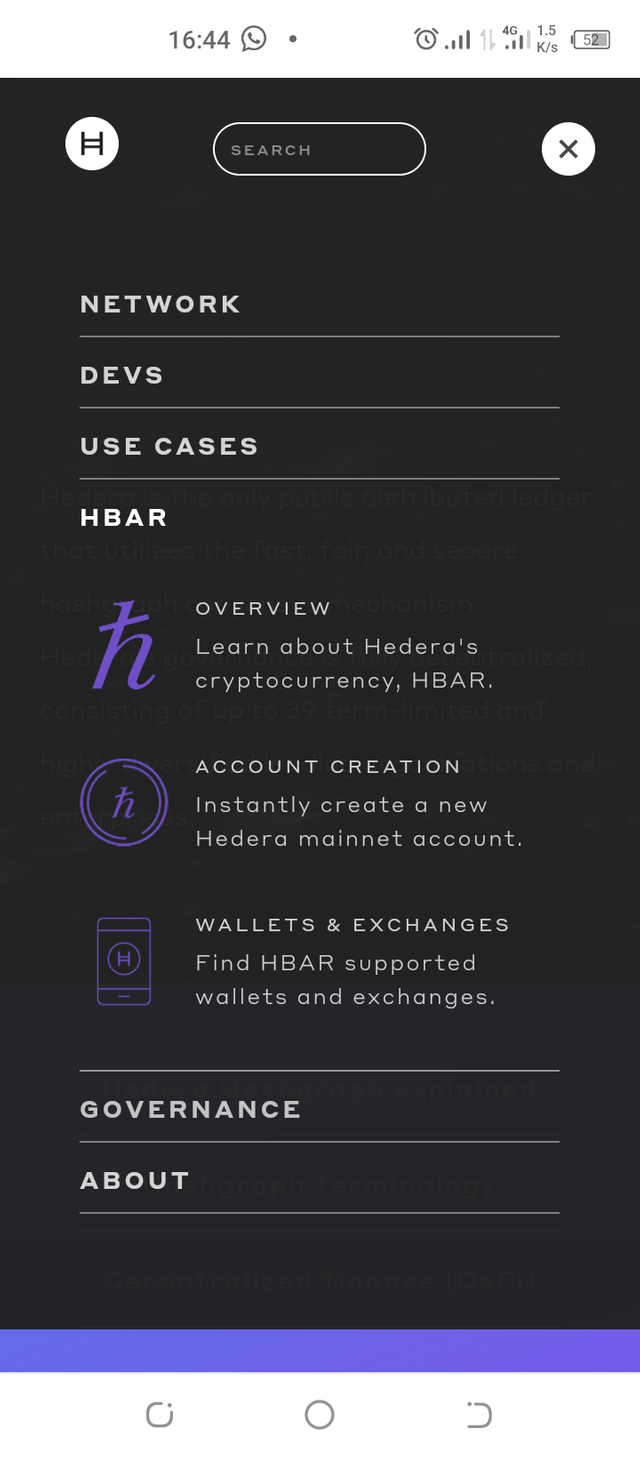
Hbar
GOVERNING COUNCIL
This is the section that gives information about the governing council of Hedera Hashgraph, as seen from the website, it consists of 39
term-limited that includes different organizations and other enterprises to make up 11 sectors with other non-profit organizations worldwide. The job of Hedera Hashgraph governing council is to continually make decisions to improve the stability of the Hedera Hashgraph and also make changes with time to better the network.

Hedera Governing council
ABOUT
This section on Hedera Hashgraph shows sub-sections like; Team, Journey, Roadmap, User Group, Careers, Media, Press, News, Blog and Papers. Each of the aforementioned links gives a user what they are looking for as regards the link title. Meet the Hedera team below.

About
Hedera Team

In conclusion, Hashgraph is with no doubt a great innovation to the crypto ecosystem as it's aimed to tackle a few shortcomings of the existing blockchain and proven to be faster, safer and secured than blockchain. Through the exploration of Hedera Hashgraph, I realized an existing permissioned blockchain can be integrated into the Hedera Hashgraph which is the only authorized Hashgraph technology at the moment. Thanks to professor
@pelon53 for this wonderful lecture.

Written by;
@fredquantum

















Gracias por participar en Steemit Crypto Academy:
Muy buen trabajo, siempre tenemos que tener en cuenta de la vida real puede ser diferente a las pruebas hechas matemáticamente. Se tendrá que esperar para observar el funcionamiento de esta nueva tecnología.
Me agradó tu explicación.
Espero seguir leyendo tus publicaciones.
Calificación: 9.2
Thanks for the review professor @pelon53.
Please which software application do you usually use to label your screenshot for your homework